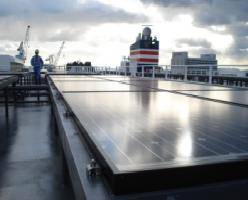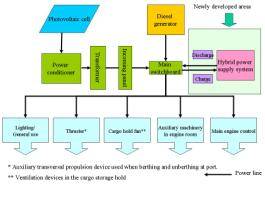First Solar-Power-Assisted Vessel in Development
—Car Carrier Auriga Leader to be Fitted with Hybrid Power Supply System and Ballast-Water Management System, and Adapted to Use Low-Sulfur Fuel —
Nippon Yusen Kabushiki Kaisha (NYUKF) (NYK Line; head office: Chiyoda-ku, Tokyo; president: Yasumi Kudo), Kawasaki Heavy Industries Ltd. (KWHIY) (KHI; head office: Kobe-shi, Hyogo Prefecture; president: Satoshi Hasegawa), the Monohakobi Technology Institute (MTI; head office: Chiyoda-ku, Tokyo; president: Yutaka Yasunaga), and Nippon Kaiji Kyokai (ClassNK; head office: Chiyoda-ku, Tokyo; chairman and president: Noboru Ueda) are to begin in June shipboard tests to verify the effects of a jointly developed hybrid power supply system for vessels. The innovative system will be installed on NYK Line’s solar-power-assisted car carrier Auriga Leader (60,213 gross tons), which will also be fitted with a ballast-water management system and adapted to use low-sulfur fuel to further strengthen environmental measures.
The power generation and endurance of the photovoltaic panels on Auriga Leader have been undergoing shipboard tests since the completion of the vessel on December 19, 2008. The tests have shown that providing a stable power supply from the photovoltaic panels is difficult because even a slight change in the weather has a significant influence on the amount of power generated. It was also found that attempting to make the solar power system bigger to gain more output and to increase its dependency could result in problems with regard to stable operations due to fluctuations in the power supply.
The hybrid power supply system has been studied since fiscal 2009.* NYK Line and MTI, with the aim of curtailing CO2 emissions, have pursued a stable onboard power supply in case an unstable renewable energy source such as solar power were to be adopted; KHI has been working to develop a hybrid power supply system for vessels through the use of its self-developed large nickel hydrogen batteries known as Gigacell®; and ClassNK is supporting these projects as part of assistance provided through a joint research scheme based on industry demands. Charging and discharging a fluctuating amount of solar power generated by this hybrid power supply system will stabilize the supply to the vessel’s electrical power system. This will also minimize output fluctuations from the diesel power generator and secure a stable power supply.
Shipboard tests on Auriga Leader will continue with the aim of achieving a stable power supply under harsh marine conditions through the combination of solar power generation and the hybrid power supply system, and the effects will be verified. Based on the experiment results, NYK Line and MTI will aim to develop an even larger solar power generation system for vessels, while KHI will seek to commercialize the hybrid power supply system for vessels.
NYK Line, KHI, MTI, and ClassNK will continue to respond proactively to environmental issues through further innovations in technology.
* The hybrid power supply system was selected as a subsidized project by the Ministry of Land, Infrastructure, Transport and Tourism (MLIT) under the “Support for Technology Development for Curtailing CO2 from Marine Vessels” program.
Source:ClassNK












